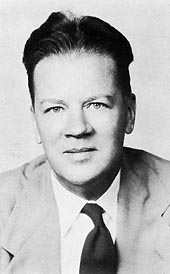-
(b.) - ?1908
Bio/Description
Born in the Mount Airy section of Philadelphia, he was the son of Samuel Reid and Lora (Chandler) Warren. In 1924, he entered the newly formed Moore School of Electrical Engineering at the University of Pennsylvania. Through a scholarship and summer jobs with the J. C. Holtby radio store in Lansdowne, Philadelphia Electric Company and Bell Telephone, he was able to continue his studies at Penn. In 1928, he received his B.S. degree in Electrical Engineering. Though tempted, as many of his class were, to begin working for private industry, he was persuaded by Harold Pender, the Dean of the School, to continue on in the graduate school. This decision marked the beginning of his long career with the University of Pennsylvania. The following year, 1929, he was granted a Master's degree in Electrical Engineering. Again, encouraged by his teachers and the dean, he progressed through the doctoral program. With the onslaught of the depression, he was forced to prolong his studies. It was not until 1937 that he finally received his Sc.D. in Electrical Engineering (the University did not grant Ph.D.'s in electrical engineering at this time). At the beginning of his doctoral studies, he became involved the field of biomedical research or development. Charles Nathan Weyl, then an assistant professor in the Moore School, had been approached by Dr. F. Maurice McPhedran of the Henry Phipps Institute of the University of Pennsylvania to assist McPhedran in the operation of x-ray machinery. Weyl agreed to help McPhedran. Knowing that he was entering the doctoral program, Weyl asked him to join in this new research. So, in 1929, he was hired as a Research Assistant by the Moore School. The research was funded by the National Tuberculosis Association and concentrated upon analysis of x-ray machinery and techniques applied to chest examinations. On his suggestion, the research team engaged in on-site inspections in tuberculous sanatoria throughout the United States and Canada. The partnership with Weyl was quite productive. By 1937, they had written one book and 15 articles on the subject. He took over the research when Weyl assumed the responsibilities of his family's printing business, and took a less active role in the project. He directed the research until 1944 at which time he became more involved in the Moore School. In January 1945 he was selected to serve as supervisor of the EDVAC project. While he was doing his x-ray research, he also was teaching in the Moore School. He was appointed Instructor in 1933. Due to his distinguished research and the respect of the faculty, he became an Assistant Professor in the Moore School and an Associate in radiological physics in the Graduate School of Medicine in 1939. The medical school course sought to familiarize physicians with the physics behind x-rays, an innovative idea for traditional medical education. This important work with the medical school led to his advancement through their tenure system, Assistant in 1942, Associate in 1947, and full status in 1951. The trek through the Moore School, however, was slightly more rapid, Associate Professor in 1944 and Full Professor in 1949. Soon after his full appointment in the Moore School, he entered into the administration as the Vice Dean in 1951. Under the 1954 reorganization of the various engineering schools at the University of Pennsylvania into the Engineering Schools, he became Assistant Vice President (later called Associate Dean) for Undergraduate Engineering Affairs, a post which he held until 1973. Possessing a position great influence in the school, Warren had the opportunity to generate discussion and attempt implementation of his unique views on undergraduate engineering education. He saw the profession as becoming too specialized and isolated. He believed that the student should have a broad and well-grounded education in the humanities, not just science. The ideal would be to have the student enter into concentrated engineering studies at graduate level, after completing a varied program in the university. By writing articles, participating in various university committees, he was able to disseminate his opinions. Though he was never able to attain this ideal, he did present these views for discussion among his peers. He was, however, able to stress the need for good student advising which he saw as the key to guiding young people in a broad education. Even after his retirement in 1976 from the College (now School) of Engineering and Allied Sciences, as it was then called, he continued to labor to this end by advising undergraduates. Though he retired from his teaching post at the University in 1976, he still worked on a number of committees. After serving on the Board of Governors for a number of years, he acted as President of the Faculty Club from 1977 to 1979. He also participated in the Honorary Degrees Committee, 1978-1981. He was quite active in a number of professional organizations, serving on close to 15 committees for the American Institute of Electrical Engineers beginning in 1943. From 1954 to 1964, he gained international recognition as the secretary of Working Group 65, Definitions in Radiology and Radiological Physics under the Technical Committee of the International Electrotechnical Commission in Geneva. Another position which he held was as a member of the Franklin Institute's Committee on Science and the Arts, which he joined in 1958. Some of the other organizations in which he participated included the American Society of Engineering Education, Engineers' Council for Professional Development, and the Etta Kappa Nu Association, a fraternity for engineers. He married Marian Stradling on September 20, 1930 and they had two sons.
-
Date of Birth:
1908 -
Noted For:
Served as supervisor of the EDVAC project at the Moore School -
Category of Achievement:
-
More Info:


